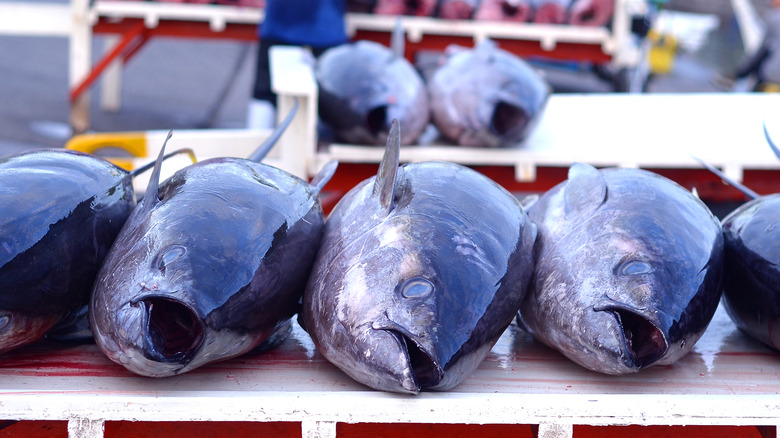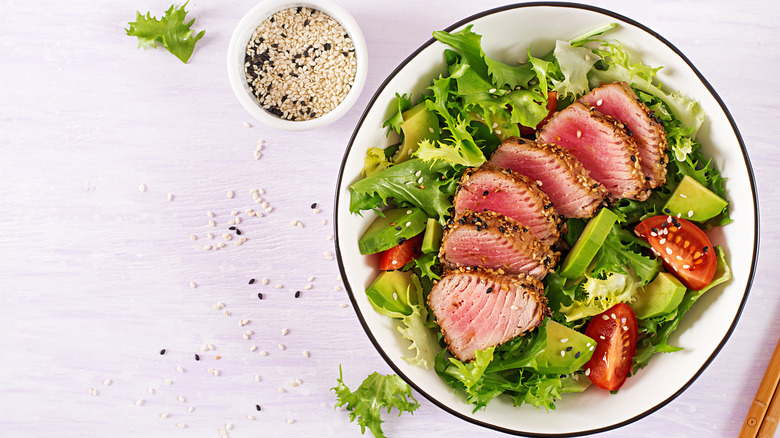Yellowfin Vs. Bigeye Ahi Tuna: What's The Difference?
Tuna is one of the most commercially and economically valuable fish species in the world, according to The Pew Charitable Trusts; reeling in billions of dollars for tuna fisheries and resale markets every year. Seven species comprise the bulk of tuna catches in both temperate and tropical oceans, providing affordable sources of protein to global populations. Fortunately, two of those stated tuna species are versatile enough for both specialty and everyday eating.
Yellowfin and bigeye tuna, aptly named for their respective prominent features, are basically two different types of the larger ahi species, explains Go Fish'n Online, a sustainable fishery in Cape Town, South Africa. The ahi name comes from the native Hawaiian language, translating as "fire" in English. Its adaptation to ahi fishing reportedly comes from the smoke created when fishing lines are quickly thrown overboard to catch the massive ahi tuna fish.
Though it's tempting to toss the two ahi tunas into the same category, true fish aficionados say that would be a mistake. Several distinctions offer subtle differences that affect appearance, flavor, texture, and preparation.
Yellowfin vs. bigeye ahi tuna
The Hawaii Seafood Council states that yellowfin and bigeye ahi species seem interchangeable to most diners, but distinct characteristics do exist. Here's a look at how the fishy family tree splits and what it means for your dinner plate.
In appearance, yellowfin tunas, as the name implies, carry dashes of bright yellow coloring in the dorsal and posterior fins as well as smaller finlets, according to the Council. Considerably slimmer than bigeyes, the yellowfins' flesh ranges from pink to a rich-red color, depending on size. Ones caught in Hawaii can weigh from 3 pounds to well over 200 pounds. In contrast, bigeyes are plump with large chunky heads and noticeably large eyes, according to a separate profile of bigeye tuna. This species also has pink-red flesh and can also weigh more than 200 pounds.
When it comes to taste, the high fat content in bigeye tuna means smooth texture and a creamy, rich flavor, explains San-J. It's a good choice for tuna steaks, as it holds up well to grilling without drying out. Yellowfin, on the other hand, imparts more subtle, mild flavors. Its firmer texture works well for thinly sliced sashimi.
Ahi tuna species are extremely versatile for general canning, grilling, searing, and raw consumption. San-J suggests trying yellowfin and bigeye in Japanese-style poke bowls, fish tacos, salads, tuna steaks, and tuna-style burgers. In appetizers, slivered ahi creates a pleasing contrast with sliced citrus fruits such as mandarins, oranges, or grapefruits.
Health and awareness
Health benefits of yellowfin and bigeye ahi tuna species are more similar than different, with each harboring loads of nutrition. Hawaii Deep Sea Fishing notes that ahi in general is a lean fish, with both subspecies carrying low amounts of saturated fat and sodium and high amounts of phosphorus, omega-3 fatty acids, magnesium, and vitamins B6 and B12. Global Seafoods points out that eating ahi may improve heart health, lower blood pressure, boost immunity, and improve blood circulation. The selenium tucked naturally into tuna could promote thyroid health, while the niacin potentially affects brain function, reducing the risk for age-related cognitive decline.
It's well known that some types of fish carry somewhat concerning levels of mercury, and ahi tuna can contain higher amounts than other tunas, per Livestrong. The concern for mercury poison primarily surfaces when diners consume ahi tuna raw in sashimi or sushi. Medical News Today states that pregnant women and young children in particular should avoid eating raw tuna, which may cause developmental and learning disabilities.


